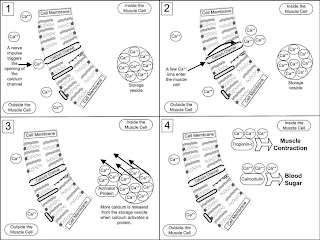Calcium plays a vital role in muscle contraction. Skeletal muscle cells have calcium channels in their cell membranes that respond to nerve impulses for contraction. When a nerve gives a signal to a muscle cell to contract, the calcium channels in the cell membrane open, allowing a few calcium ions into the muscle cell.
Once inside the cell, the calcium ions attach to activator proteins in the cell, as seen in Figure 9-2. The activator proteins in the cell trigger the release of large numbers of calcium ions from storage inside the cell. These released calcium ions bind to a protein, troponin-c, leading to muscle contraction. To assist the contraction, calcium also binds to another protein, calmodulin. Calmodulin helps release blood.
Figure 9-2 Calcium enables muscle contractions.
sugar from storage to fuel the contraction. Calcium channels are used by many cells for cell signaling.
Once inside the cell, the calcium ions attach to activator proteins in the cell, as seen in Figure 9-2. The activator proteins in the cell trigger the release of large numbers of calcium ions from storage inside the cell. These released calcium ions bind to a protein, troponin-c, leading to muscle contraction. To assist the contraction, calcium also binds to another protein, calmodulin. Calmodulin helps release blood.
Figure 9-2 Calcium enables muscle contractions.
sugar from storage to fuel the contraction. Calcium channels are used by many cells for cell signaling.
More about Calcium:

0 comments